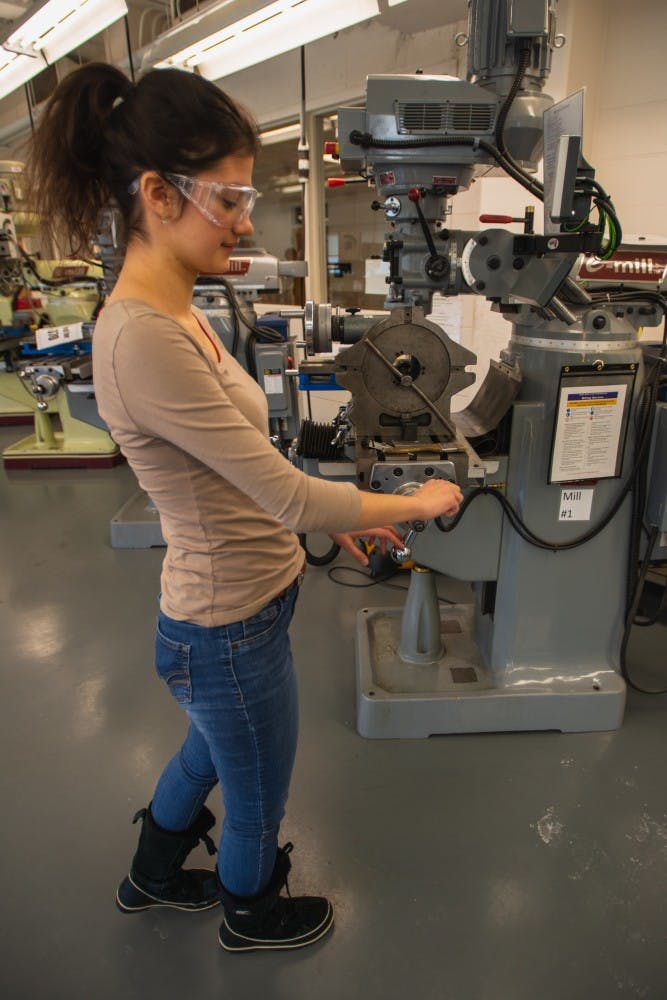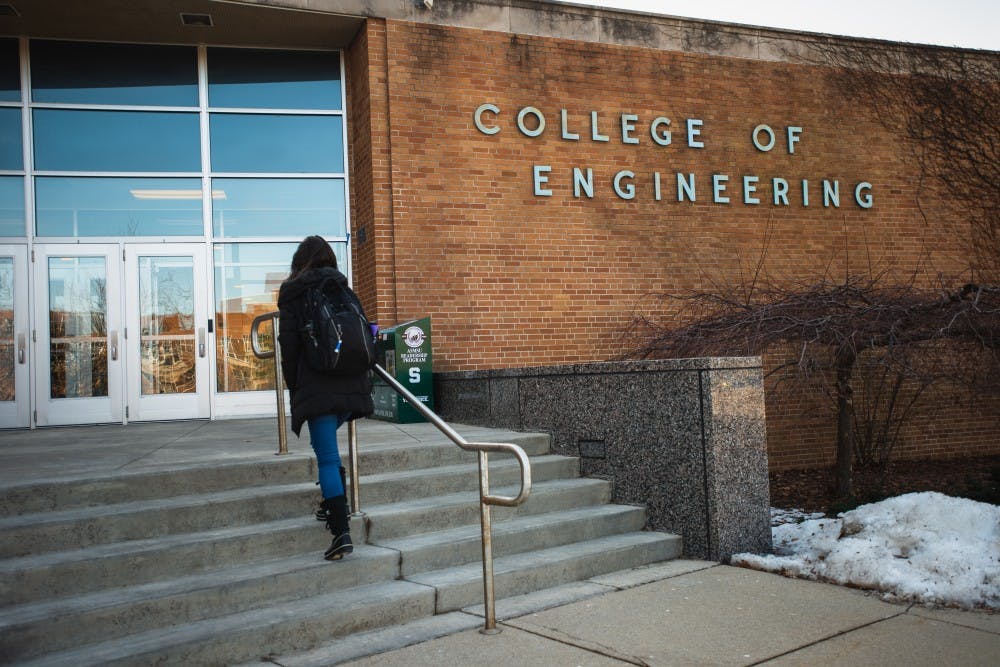Elizabeth Schester knows what it’s like to be the only girl in a room. The contrast between the number of men and women in her college classes stands out to her so much that she now tallies the number of women in each one she takes.
In 'male-dominated' career field, engineering junior persists
The Michigan State junior speaks Romanian and English, takes intense upper-level mechanical engineering courses and hopes to someday work for NASA. Between it all, Elizabeth is one of many women trying to enter a STEM career – a work field dominated by men, studies have shown.

A rigorous career choice
Elizabeth’s interest in engineering was piqued by her mom, Liliana Schester, who’s also an engineer. While both of Elizabeth’s parents have influenced her career choices, her mom’s job especially stood out. Liliana works as a senior engineer of supply and development for GT Technologies, an automotive company in Detroit. Elizabeth said she has looked up to her mom since she was little.
“She’s always been very influential in trying to encourage my brother and I to go forward in a STEM-related field,” Elizabeth said, referring to science, technology, engineering and math.
Her class schedule — which consists of mechanical engineering and material science courses — requires dedication. Such STEM courses require her to take careful notes and listen intently to what her professors teach, and it’s easy to get lost in the sea of people that make up her large lectures and other classes, she said.
“It’s like high school, but everything counts a lot more and has a lot more weight,” Elizabeth said.
In those classes, Elizabeth takes note of her fellow students. A large majority of them are male – something that’s only become more prominent as she’s progressed in her education.
“As I continue getting more and more high-level, I do notice a little bit more of that difference,” Elizabeth said.
“It is male-dominated”
This divide is stark, Elizabeth said, and she works to not let it affect her outlook on her choice of major.
“I try not to let it affect me,” Elizabeth said. “I look at it now and half of my friends, if not more, happen to be guys, and for me that’s normal and I don’t have a problem with it.”
READ MORE
For example, one class she took this past summer stood out to her.
“I did classes and I think out of 24 students who were there, four of them were girls,” Schester said. “I thought we just stood out because we were there.”
Elizabeth is used to fewer women in her mechanical engineering classes, so she’s surprised when she takes a class with a more even ratio. Last semester, she took a higher-level mechanical engineering class and was shocked at the number of girls enrolled in it along with her.
“In the lab, there were 15 of us total and there were six girls. For me, I was shocked,” Elizabeth said. “That’s a big number. I think we had four different groups and each group had at least one girl. I thought that was pretty heartwarming.”
Other classes aren’t composed the same way.

Junior mechanical engineering student Elizabeth Schester poses outside of the Engineering Building on March 11, 2019.
Support student media! Please consider donating to The State News and help fund the future of journalism.
“Other sessions, they weren’t always the same,” Elizabeth said. “One of my friends told me that she was the only girl out of the whole 15 students who were there.”
The divide leads women in STEM careers to seek out and bond with their female colleagues, Elizabeth said.
“It is male-dominated, but in some ways it doesn’t have to be,” Elizabeth said. “That’s just how chances are. Us girls – we all stick together as such.”
Julia Lutz, Elizabeth’s friend, is also a mechanical engineering junior. Lutz echoed Elizabeth and said, though she believes MSU does an adequate job of recruiting women into STEM programs, it’s disappointing to see fewer girls.
“It seems like the farther I get in my academic career, there’s less and less girls,” Lutz said. “It’s a little bit disappointing to see, that there’s not more girls.”
Lutz hasn’t been treated differently than her male colleagues so far, she said. Her experience with other engineering students has been accepting of women for the most part.
“Most of the time, most of the engineering students are very friendly and accepting to girls being in engineering more frequently nowadays,” Lutz said.
Entrance into a STEM career appears to have become easier for women for two reasons, Lutz said: One, because other women in the same field uplift each other, and two, because a stigma of women “not being good enough” for work in that field is being diminished.
“I think girls tend to band together ... just the farther we get, as the numbers go down, the bond goes up,” Lutz said.
Making STEM accessible for other women
Elizabeth started working with Women in Engineering K-12 outreach at MSU last semester. She talked about one of the events she helped with, where more than 500 girls — all 4th to 8th graders — signed up for an “Introduce a Girl to Engineering Day.”
“That was just so cool to see, this big event come together,” Elizabeth said. “It has been nothing but eye-opening and a pleasant experience.”
Like Elizabeth, Lutz was inspired to move into assisting outreach efforts for girls interested in STEM programs. Before she attended MSU, she went to Detroit to listen to two panels of women engineers at MSU. That made her want to be like them, she said.
She is now part of the Society of Women Engineers – a nonprofit educational service organization “composed of science and engineering and graduate engineers,” according to its website.
“The Society of Women Engineers brings in kindergartners all the way up through high schoolers at different parts of the year and gets girls excited about engineering.”
It’s women — like Liliana’s own daughter and Lutz — who inspire other girls to enter STEM careers, Liliana said.
“In America, women in the engineering field … you see less,” Liliana said. “However, as time goes by, you see more younger girls coming and trying the field.”

A mechanical engineering student walks into the Engineering Building on March 11, 2019.
What’s in store for Elizabeth’s career
The question is what lies in store for Elizabeth’s future.
“There’s so much to do, so much I would just like to try at once,” Elizabeth said.
Liliana said Elizabeth’s choice to follow in her footsteps was not always clear. And Liliana admits STEM fields can be difficult for women to enter, but she had faith as she watched Elizabeth go through her studies in high school and college.
“She understood and she has the capabilities of studying, so she’s succeeding,” Liliana said.
Liliana has noticed the divide between men and women in STEM fields professionally, too.
“It’s a place where it’s dominated by men and they seem to foster an environment where sometimes they make women feel uncomfortable because of little cliques or because they try to impress that they are smarter than women,” Liliana said.
But Elizabeth won’t let that effect her.
Instead, she puts her hair up in a ponytail and wields heavy machinery and tools like any of her fellow classmates of the male variety.
She talks about her dream of working for NASA, given the organization’s historical legacy.
But Elizabeth would be just as satisfied with a job that fulfills her, like Liliana’s job fulfills her. Liliana travels a lot for her job – all over the United States, Europe and South Korea.
“I think seeing her travel and getting all these experiences and her love for her job is also something I also want to do,” Elizabeth said. There’s a lot of different people in my life who have pushed me toward what I’m doing today.”








